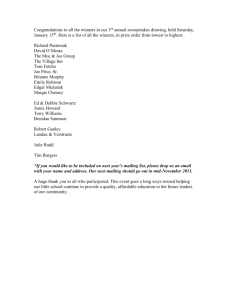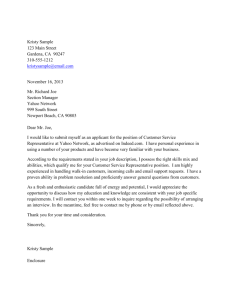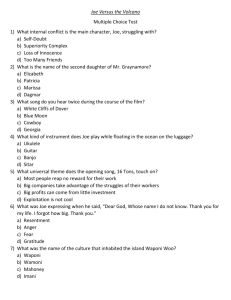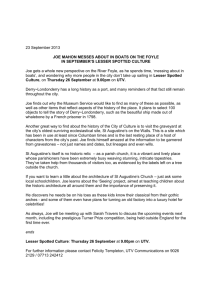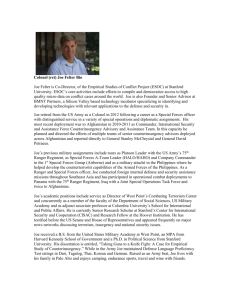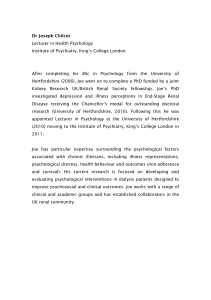A Dangerous Fiction: Challenging the Perception of Masculinity in
advertisement
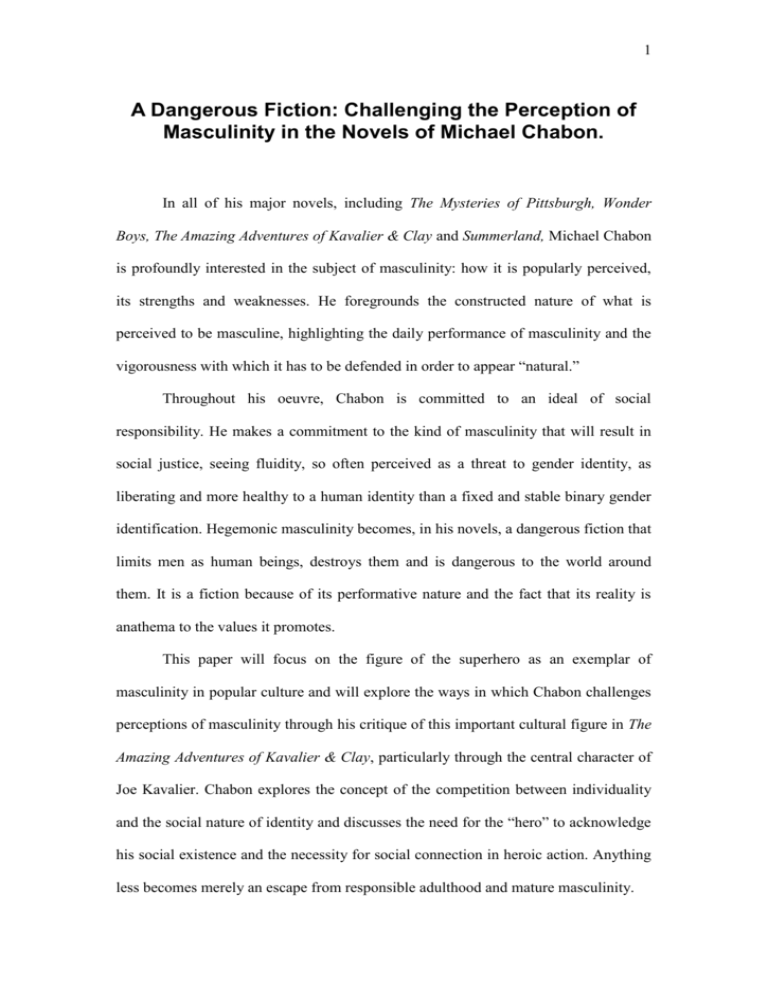
1 A Dangerous Fiction: Challenging the Perception of Masculinity in the Novels of Michael Chabon. In all of his major novels, including The Mysteries of Pittsburgh, Wonder Boys, The Amazing Adventures of Kavalier & Clay and Summerland, Michael Chabon is profoundly interested in the subject of masculinity: how it is popularly perceived, its strengths and weaknesses. He foregrounds the constructed nature of what is perceived to be masculine, highlighting the daily performance of masculinity and the vigorousness with which it has to be defended in order to appear “natural.” Throughout his oeuvre, Chabon is committed to an ideal of social responsibility. He makes a commitment to the kind of masculinity that will result in social justice, seeing fluidity, so often perceived as a threat to gender identity, as liberating and more healthy to a human identity than a fixed and stable binary gender identification. Hegemonic masculinity becomes, in his novels, a dangerous fiction that limits men as human beings, destroys them and is dangerous to the world around them. It is a fiction because of its performative nature and the fact that its reality is anathema to the values it promotes. This paper will focus on the figure of the superhero as an exemplar of masculinity in popular culture and will explore the ways in which Chabon challenges perceptions of masculinity through his critique of this important cultural figure in The Amazing Adventures of Kavalier & Clay, particularly through the central character of Joe Kavalier. Chabon explores the concept of the competition between individuality and the social nature of identity and discusses the need for the “hero” to acknowledge his social existence and the necessity for social connection in heroic action. Anything less becomes merely an escape from responsible adulthood and mature masculinity. 2 Chabon takes the concept of the superhero and works from within the paradigm to tease out the positive aspects of the mythology and incorporate these into a new conception of masculinity. His novel attempts to reunite dualisms inherent in the form, showing that both sides of the binary hero/alter-ego – which is mapped onto strong/weak; masculine/feminine – constitute the inseparable dialectic identified by Jeffrey A. Brown: “these two male extremes are not so far removed as they might seem. Warrior and wimp exist side by side, each defining the other in mutual opposition.” (Brown, 1993) Chabon’s text also suggests that they combine to create a “masculine” identity. As a result, the text calls for a shift in the perception of masculinity and argues that to be “masculine” should not mean fully and completely polarising and negating the “weak” or “feminine.” The two main characters of The Amazing Adventures of Kavalier & Clay are both minority members of their society’s hegemonic gender. Josef is Jewish, an immigrant who has escaped from Nazi-ruled Czechoslovakia. Sammy, though born in America, is doubly marginalised as he is Jewish and homosexual. Recognising the status of the two men as minorities within the dominant gender provides a very fertile starting point for an assessment of Chabon’s novel. David Buchbinder warns against the tendency for “ ‘patriarchy’ and ‘masculinity’ [to] often become conflated,” (Buchbinder, 1994) the problem being that not all men, even within a patriarchal society, have equal access to power. This is particularly salient within the World War II context of the main part of the novel’s narrative. Persecution of the Jews in Nazi Germany has been characterised by Brown, utilising the work of Klaus Theweleit in Male Fantasies, as a process of “othering”; creating out of the totality of the Jewish people an “Other” to the assumed, universal and masculine Aryan master. Brown notes that “the Jewish man,” has “been burdened 3 by the projection of castrated softness.” (Brown, 1993) It is this kind of “softness” that Joe fights against in his war against all Germans in New York and, eventually, Antarctica. Sammy is doubly troubled as he not only has to fight the stereotype of the “soft” Jew but also the “sissy” homosexual. Each attempts to reassert their masculine voice through their work and personal lives. As a result of their perceived weakness within their gender, both of these young men look up to and create muscular, independent and powerful, hypermasculine men in order to feel some sense of masculine empowerment themselves. They project all of their weaknesses onto the alter-ego and the superhero obliterates them. The Escapist, equal parts superhero and Harry Houdini, is alter-ego of the limping Tom Mayflower, a blue-clad superhero who frees the masses from their shackles of oppression with the aid of his golden key. On one level, this is exactly how the Escapist functions for the two cousins. However, he is also an icon of impenetrability and phallic power, the epitome of masculinity. This is realised through the violent repression or destruction of anything that threatens the stable masculinity of an individual. Antony Easthope’s model for masculinity is the perfect vehicle for reading the superhero, for Easthope’s concept of masculinity centres on an attempt to completely expel the feminine. The superhero’s split between feminised alter-ego and hypermasculine hero graphically illustrates this point. Easthope conceptualises the male ego using the model of the castle: “The castle of the ego is defined by its perimeter and the line drawn between what is inside and what is outside.” (Easthope, 1986) This reads like a blueprint for the idea of the superhero. The union suit in which the superhero is traditionally clad effectively seals off any gaps in the body’s perimeter and foregrounds the masculine body’s impenetrability. 4 With Joe’s potency threatened by his exile and disempowerment, he reemphasises and performs his masculinity through the Escapist, his intention being to save his family through the appropriate “manly” medium of violence. Through the Escapist, Joe fights the Nazis and attempts to gain the freedom for his family that he cannot realise in reality. The Escapist is thus set up as an icon. Through the adoration of his image and metaphysical “meaning,” Joe intends to gain access to his heart’s truest desires; to attain the unattainable. This becomes the driving force of Joe’s life in America – his attempt to exact revenge against a cruel world. As a “Kavalier,” Joe is set up in the traditional role of questing knight. His narrative generally conforms to the pattern established by Joseph Campbell: “a separation from the world, a penetration to some source of power, and a lifeenhancing return.” (Campbell, 1968) Generally, the quester must give up social connection in order to keep the purity of his pursuit in tact – he has one mission and one mission only, anything that could possibly hinder his quest must be forsaken. 1 Of the hero’s need for isolation from worldly desires Campbell writes, To a man . . . courageously responding to the dynamics of his own nature – to a man who is, as Nietzsche phrases it, “a wheel rolling of itself” – difficulties melt and the unpredictable highway opens as it goes. (Campbell, 1968) Chabon’s text suggests the dangers of such a vision. Joe is nothing if not “a wheel rolling of itself”; however, he has nothing but difficulties throughout the bulk of the narrative. The singlemindedness of his vision blinds him and makes his path all the more dangerous and distorted. 1 Campbell acknowledges that the hero may have helpers, but they remain unattached, only there to perform their function. The quest remains the hero’s and the hero’s alone. Others are only there for the help or hindrances they can give. Campbell outlines the hero’s journey. (Campbell, 1968). 5 Joe’s emasculation through the business deal with Sheldon Anapol and Jack Ashkenazy regarding his and Sammy’s remuneration for the Escapist character causes a reaction; a reassertion of his masculinity through performance of the one masculine ideal that Joe perceives has any power – violence. David Buchbinder reasons that the repression of emotion by many men leads to the signification of “anger and aggression” as “appropriate ‘manly’ feelings.” (Buchbinder, 1994) Joe becomes convinced that violence is power and it is the only way a man can win. Chabon contextualises the advent of violent comic books within a violent culture and thus complicates the simplistic argument that comics cause violence. The Amazing Adventures of Kavalier & Clay contends that violent comics are also the result of a world that teaches its inhabitants that power is analogous to the oppression and extermination of one’s enemies. Joe perceives, and to a large extent has been taught by the world which produces him, that he must strive to be like the Escapist to have anything like the transcendent power he promises. It is not enough anymore to just to create a superhero, Joe needs to become one. The titillation of vicarious comic book violence is no longer enough. Joe graduates to the violent satisfaction of his desires. The Amazing Adventures of Kavalier & Clay argues that the “real” purpose of superheroes is exactly the opposite to Fredric Wertham’s characterisation of them as fascist Aryans.2 (Wertham, 1955) Chabon does not so much reject outright Wertham’s arguments but indicates that they are more complex than Wertham’s treatise would suggest. Instead, superheroes encapsulate the sublimated desires of young Jewish men who want to fight Nazi atrocities. The novel, though, complicates the matter further by exposing the destructiveness of this phenomenon. The reality is that these superheroes employ the tactics of the enemy in order to battle and, therefore, are This is a thoroughly incomprehensible statement seeing that the most famous of superheroes – Superman – is hardly physically the Aryan or “Nordic” ideal. Sammy makes the argument that, in fact, all superheroes are Jewish.(Chabon, 2000). 2 6 ultimately no better than the men they were created to challenge. As a result, throughout the novel, Joe comes to increasingly resemble what he hates most. The Antarctica episode of the novel is crucial in Joe’s story of guilt, violence and redemption. It is also the key section of the novel that finally disrupts the binary way of thinking about the hero and the villain, alerting readers to the crucial element of perspective in appraising any situation. While monitoring the radio for the presence of Nazis, Joe hears a broadcast about the “Theresienstadt Model Ghetto” in Terezin, Czechoslovakia. In Joe’s perception, the Ghetto is a “witch’s house” used to “lure children and fatten them for the table.” (Chabon, 2000) In Joe’s perception, the Jews of Europe are infantilised, thus providing more impetus for him to reassert his status as a “man.” Warren Rosenberg writes that in Jewish mythology, “With few exceptions, this heroic model is gendered. Warriors are expected to be men.” (Rosenberg, 2001) Equally, the implication of this reasoning is that being a warrior makes a male a “Man.” Joe’s assumption of the warrior role is his way of asserting and constructing his masculinity. Given The Amazing Adventures of Kavalier & Clay’s immersion in the world of comic books, it is difficult not to see Joe, while hidden away in the radio shack, as reminiscent of Superman in his “Fortress of Solitude.” Joe secludes himself in order to plan for his transformation into an exemplar of invulnerable masculine power, willing to fight the Germans for the sake of the downtrodden peoples of Europe. However, Chabon also allows an insight into the down-side of male solitude. Intently listening to all that goes on outside the shack, Joe comes across a German transmission that sounds local, alerting him to the presence of “Germans on the Ice.” (Chabon, 2000) Because of his isolation, Joe becomes paranoid at the thought of 7 invaders. Superman effectively becomes the creature in Kafka’s “The Burrow.”3 (Kafka, 1961) His perceptions are warped and Joe is led to possibly the greatest tragic event of his life. The accumulation of Joe’s feelings of impotence, through exile to the United States and service in Antarctica, culminates in an act of violent phallic masculinity where he shoots the Geologist in an act of sexual and symbolic potency – penetration causing death. Rosenberg’s reading of Jewish writers, E.L. Doctorow, Herb Gardner, David Mamet and Mark Helprin, apply to Chabon’s representation of Joe as well: “Identity, male and Jewish, has been lost, and the process of remasculinization attempts to reclaim them both simultaneously, one in terms of the other. The glue that connects these elements is violence.” (Rosenberg, 2001) All of Joe’s frustrations should be able to be consumed by this one act. It is the kind of act that Easthope argues is used to affirm masculinity: Energy bound to make up the ‘I’ is released against everything that appears to attack it. The unity of the body is affirmed when the body of the other is destroyed. (Easthope, 1986) When couched in this kind of rhetoric it is possible to see the similarities between Joe and other authoritarian figures in the text, such as the G-men who rape Sammy. Up until now, the superhero has been used by Joe as an icon to deny any gaps in the façade of masculinity: his violent confrontations, hard body and inevitable victory proving the strength and consistency of his masculinity. However, at this point Joe lets the “inside” out and in his vulnerability and “softness” becomes truly heroic. Hegemonic masculinity becomes reformulated as an escape into the safety of conformity and an attempted escape into the safety of perceived stable gender There are many allusions to Kafka throughout the novel, not the least Joe’s name – Josef K – and his origins in Prague. 3 8 identity. Responsibility to the world and real situations is abrogated through deference to hegemonic masculinity. Joe’s act of penetrating the German does indeed confer a sense of identity on him. This identity, though, is of a different character to that which he expected. Rather than reaffirming Joe’s masculinity, the act of piercing another’s body confronts Joe with the reality of the grotesque body as opposed to the very hard and clean body of the superhero which had been fetishised up until this point. This revelation of the corporeality of the male body is a point of renewal for Joe and results in his identification of their common humanity. Joe is set for a rebirth, (See Campbell, 1968) not as an all-conquering warrior but as a human being – a dialogue of both masculine and feminine voices. When Klaus Mecklenburg dies, far from Joe’s expectations, his death breaks Joe’s heart: The shock and fragrance of life, steaming red life, given off by the trail of the German’s blood in the snow was a reproach to Joe . . . In seeking revenge, he had allied himself with the Ice, with the interminable white topography, with the sawteeth and crevasses of death. Nothing that had ever happened to him . . . had ever broken his heart quite as terribly as the realization, when he was halfway to the rimed zinc hatch of the German station, that he was hauling a corpse behind him. (Chabon, 2000) The text asserts that violence is not what Joe needs to reconcile himself with his past and his future. In its representation of the death of Klaus Mecklenburg, The Amazing Adventures of Kavalier & Clay writes back into the comic book narrative emotion and the corporeal reality of death, with its emphasis on the blood of the victim, and highlights the falsity of the quest on which Joe had embarked. Revenge solves nothing 9 and Joe’s attempts to gain control of his life through performing solitary acts of violence and willfulness have resulted in the greatest tragedy of his life. The loss of his enemy is a greater tragedy than the loss of his family, the novel tells us, the implication being that in killing his enemy, Joe loses himself and his values.4 The novel warns that Joe, and with him men in general, need to find a way to integrate these concepts back into their lives if they are to truly live up to heroic standards. In trying to emulate the superhero, Joe suppresses his humanity. He resembles what Frank Miller identifies as a defining characteristic of the Batman: “Batman imposes his order on the world; he is an absolute control freak.” (Sharrett, 1991) This is precisely what Joe has tried to do and the text shows us he cannot. In assuming this mentality, Joe has become equally as fascistic as his oppressors. His intolerance of passivity leads to his over-identification with the violent hypermasculine and the subsequent loss of his humanity. The novel concludes that reconciliation and peace are only capable through creation and production, not destruction. In The Amazing Adventures of Kavalier & Clay the slaying of giants,5 ogres, dragons is removed from the hero’s journey and are transformed into destructive events in the life of an individual. To become heroic, Joe, has to come to terms with his own path and identity through creative and responsible practices that bring beauty and renewal to the world rather than death and destruction. Through his comic series, The Golem, which combines an iconic American form with Czech-Jewish content, Joe is able to achieve a cultural amalgamation that enables him to create a space where he can find a home. He keeps a connection to his Chabon’s representation of Joe’s dilemma resonates with Susan Faludi’s representation of the culture inherited by the sons of the men who fought in World War II: “And what act could be more crudely and stereotypically masculine than a show of violence? But while violence uses all the visible aspects of male utility – strength, decisiveness, courage, even skill – its purpose is only to dismantle and destroy. Violence stands in for action but is also an act of concealment, a threatening mask that hides a lack of purpose.” (Faludi, 2000). 5 Joe kills Klaus Mecklenburg at Jotunheim, the land of the giants in Norse mythology. 4 10 Czech-Jewish identity, keeping that culture alive, while becoming part of America, his new home. Joe finally realises that he can live in America and still be Jewish. It is the life giving force (a traditionally feminine ideal, but performed in part through the exclusively male act of Golem making, thus a synthesis of masculine and feminine ideals) realised through both The Golem and Joe’s meeting of his son, Tommy, and his taking an active role in fathering, that allows Joe to really start to live. The final image we are left with in the novel is that of synthesis. This is the kind of synthesis that Brown speaks of when he discusses the Milestone comics6: their reworking allows pervasive and popular conceptions of gender and race to be expanded by incorporating previously dissociated concepts of softness with hardness, of mind with body. Instead of merely championing the Clark Kent side of masculine duality as a legitimate role in and of itself, the Milestone books work to infuse gentler, more responsible, and more cerebral qualities within the codes of dominant masculinity. (Brown, 1993) From within the hegemonic framework of the superhero, Chabon challenges the hypermasculine ideal and infuses it with a sense of “femininity”; of passivity and nurturance. At the end of the novel, Joe has proven his “hardness” and realises that he can only become whole once he acknowledges “softness.” Ultimately, Chabon’s novel illustrates that in the attempt to live up to impossible perceptions of masculinity – epitomised here by the superhero/warrior ideal – men are made subject to and divested of any personal or “real” power. The only power they have is a façade and it merely works to sustain a hierarchy of power relationships to which they are subject. 6 Comics made by publisher Milestone that all rework an image of heroic black masculinity. 11 References Brown, J. A. (1993). Comic Book Masculinity and the New Black Superhero. African American Review, 33(1), 25-42. Buchbinder, D. (1994). Masculinities and Identities. Carlton: Melbourne University Press. Campbell, J. (1968). The Hero with a Thousand Faces (Second ed.). Princeton: Princeton University Press. Chabon, M. (2000). The Amazing Adventures of Kavalier & Clay. London: Fourth Estate. Easthope, A. (1986). What a Man's Gotta Do: The Masculine Myth in Popular Culture. London: Grafton Books. Faludi, S. (2000). Stiffed: The Betrayal of Modern Man. London: Vintage. Kafka, F. (1961). The Burrow (W. Muir & E. Muir, Trans.). In Metamorphosis and Other Stories. Middlesex: Penguin. Rosenberg, W. (2001). Legacy of Rage: Jewish Masculinity, Violence, and Culture. Massachusetts: University of Massachusetts Press. Sharrett, C. (1991). Batman and the Twilight of the Idols: An Interview with Frank Miller. In R. E. P. W. Uriccio (Ed.), The Many Lives of the Batman: Critical Approaches to a Superhero and His Media. New York: Routlege. Wertham, F. (1955). Seduction of the Innocent. London: Museum Press Limited.

